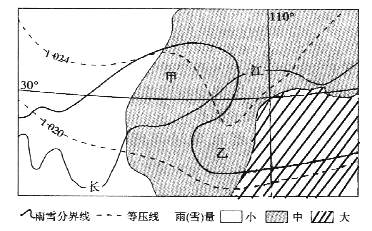问题
单项选择题 案例分析题
下图为我国某地局部降水(雪)分布图。读图,完成下列各题。

下列对甲、乙两地天气的叙述,正确的有()
①甲地中雨,乙地中雪
②甲地小雪,乙地小雨
③甲、乙两地风向均为偏北风,乙地风力较强
④甲、乙两地风向均为偏南风,甲地风力较强
A.①③
B.①④
C.②③
D.②④
答案
参考答案:A
解析:
根据图示,甲乙两地降雨(雪)强度为中等,甲地在雨雪分界线以南,为中雨,乙地在雨雪分界线以北,为中雪。图中两条等压线偏北的一条值较高,所以甲乙两地都是偏北风;乙地比甲地的等压线密集,风力比甲地大。
考点:等值线图
